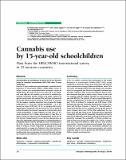Cannabis use by 15-year old schoolchildren. Data from the HBSC/WHO international survey in 32 countries.

View/
Date
2007Author
Nic Gabhainn, Saoirse
Metadata
Show full item recordUsage
This item's downloads: 239 (view details)
Recommended Citation
Godeau, E., Vignes, C., ter Bogt, T., Nic Gabhainn, S. & Navarro, F. (2007). Cannabis use by 15-year old schoolchildren. Data from the HBSC/WHO international survey in 32 countries. Alcoologie et Addictologie, 29, s28-s34
Published Version
Abstract
In the 32 western countries that participated in the Health Behaviour in School-aged Children (HBSC-2002) survey conducted in schools by means of an anonymous self-administered questionnaire among 45,848 schoolchildren, about 20% of 15-year-olds declared that they had already used cannabis, which is consequently the third most frequently consumed psychoactive substance after alcohol and tobacco. Boys are heavier consumers than girls in every country. France is one of the ten countries with the highest cannabis use rates among 15-year-olds (29.8%). The majority of users surveyed belonged to groups of experimental use (once or twice during the previous year: 7.9% of children) or moderate use (3-39 times: 7.3%); these groups were less frequently represented in Eastern, Northern and Southern Europe, in favour of "discontinuation" (have tried cannabis, but no cannabis use during the previous year). Frequent use is rarer (2.7%). After adjustment for economic level and age, being a boy, smoking tobacco (especially frequently), drinking alcohol (especially frequently) and having been drunk (especially more than twice) significantly and independently increased the probability of having smoked cannabis at least once during the subject's life. Finally, a correlation was observed between daily tobacco and alcohol consumption, frequent drunkenness and passage from experimental use to more frequent use. Psychoactive substance use is therefore rarely isolated among young people, and certain subgroups appear to be at greater risk and therefore warrant further research and prevention.

